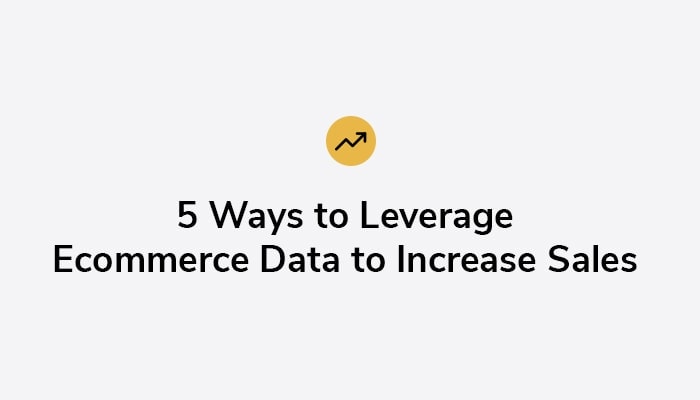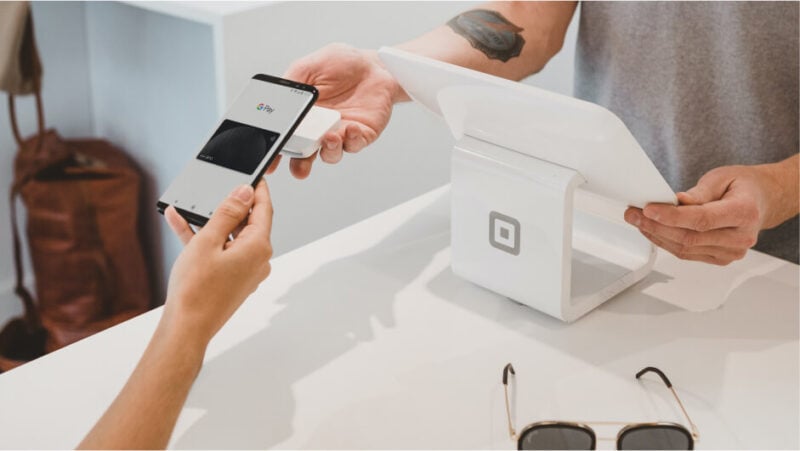Increase Conversions with Your Ecommerce Data

#1 From Ecommerce Data to Actionable Intelligence
Digital retailers collect an extraordinarily rich set of ecommerce data—more than enough to craft compelling, highly personalized journeys for all their customers. Yet for many brands, marketers are able to access, analyze, and activate only a small percentage of that data in actual campaigns.
That might not have been a deal-breaker in the past, but in today’s hyper-competitive retail market, personalization at scale has become a business imperative. The reasons for this are simple. Customer acquisition costs (CAC) keep rising year after year. At the same time, lifetime customer value (LCV) is, on average, stagnant or even declining. Clearly, this is a situation that, as celebrated analyst Mary Meeker has said, is unsustainable—at least for retailers relying on traditional marketing strategies.
The good news is, the rewards are impressive for those brands that can leverage their ecommerce data to create personalized, connected customer journeys that drive conversion and retention. After all, keeping an existing customer costs far less than acquiring a new customer—upwards of 80% less. And if you can convert just a small percentage of one-time buyers into repeat customers, the effect on the bottom line can be impressive.
In the past, the kinds of sophisticated, personalized marketing campaigns that could support these goals required expensive IT and data analytics resources to give marketers the insights they needed. However, that no longer has to be the case for brands that deploy a technology that Gartner calls smart hubs (i.e. CDPs). Brands are already using them to increase repeat purchases, increase conversion rates, reduce CAC, and more.
#2 Hidden Ecommerce Data Silos are the Enemy
In general, ecommerce retailers have no problem with big data collection. Customer-facing systems—websites, mobile apps, email campaigns, purchase and return transactions, and even call center interactions—automatically gather and store vast amounts of information about the interactions your customers have with your brand.
The problem is, most marketers lack direct, interactive access to all that real-time data. Instead, they have to wait in queues for scarce, expensive IT and data analytics experts to gather and cleanse that data.
Traditionally, brands have tried to solve this problem with all kinds of point solutions and/or expensive in-house solutions. Here are two of the most common approaches, and the limitations they present:
- Enterprise Data Warehouses. Many retailers have architected and built enterprise data warehouses to gather and unify all their ecommerce and other customer data. This can take a year or more—and entails a great deal of expense and effort. And yet these data warehouses generally rely on rigid data definitions, and therefore they lack the flexibility to quickly accommodate inevitable changes in existing data sources, as well as data from critical new sources—i.e. a new marketing channel. That lack of agility is a serious impediment in a digital marketplace that is changing at breakneck speed.
- Marketing clouds (MCs). Ecommerce retailers have also tried to solve this problem by going all in with a single MC provider. MCs promise to unify all your ecommerce marketing channels, as well as all your customer data. However, they often leave customers struggling with one or more of the following:
- Fragmented data. Because MCs were cobbled together quickly over a short period of time, the source data from different marketing channels is not always unified across channels. That leaves retailers stuck with the same data they thought they were avoiding in the first place by investing in MCs.
- Marketing reliance on IT. It is not easy to create an intuitive interface that allows marketers to access and interact with all relevant data, and MCs are generally a long way from providing this, despite the fact that leading MCs have announced plans to provide smart hub capabilities.
- Lack of agility. To keep ecommerce data unified, MCs require you to go all in with their products. Besides paying a premium to do so, this means you lose the agility to adopt best-of-breed solutions from other providers. After all, this would risk even greater fragmentation at the levels of data, analytics, and cross-channel orchestration.
In the end, ecommerce retailers often end up running campaigns on only a small portion of the ecommerce data and other customer insights they already possess. And so they end up falling back on generic “what’s new” and “you also might like” messaging. Or they do retargeting based on a single customer behavior, like a digital ad click or product page browsed. These strategies may have worked in the past, but a recent study reveals how much less effective they are becoming. For example:
- 77% percent of consumers report seeing too many retargeted ads from a single retailer
- 88% see ads for products already purchased
- 57% believe retargeted ads didn’t influence purchasing decisions.
#3 A Foundation for Modern Segmentation
The idea of retargeting makes sense. Even a single customer behavior can reveal the customer’s present “context”—i.e. the fact that they are browsing or clicking ads in real time. This indicates both preference for a certain kind of product, and the possibility that they are in “buying mode.”
However, if you really want to increase sales and drive retention, you must leverage that contextual information much more effectively than via basic retargeting. How is this possible? By enriching it with a customer’s historic interactions with your brand over time—not just behaviors over the last hour, day, week or month.
This combination of historical and contextual data is the foundation for understanding your customers’ preferences, spending patterns, critical engagement signals, etc. It provides a much more holistic understanding of your customers—and you are able to present helpful and/or enticing experiences just as they indicate that they are in, or at least moving toward, buying mode.
With this in mind, let’s consider what it actually takes to create a foundation for this modern approach to customer & behavioral segmentation and personalization.
Essentially, it comes down to four capabilities, all of which must be seamlessly connected, if you want to avoid the kind of IT/tech bottlenecks of the past:
- Data unification. You need to gather data from all systems—both historic and streaming/real time—and automatically combine all that data into unique customer records.
- Predictive analytics. You need to be able to discover opportunities with analytics tools such as artificial intelligence (AI) and machine learning (ML) that have seamless access to all that granular ecommerce data.
- Business-friendly user interface. Marketers—the people who know your customers and businesses best—need to be able to access data and insights (e.g. predictive customer scoring) on their own and combine them in creative ways to discover opportunities and create highly targeted segments.
- Orchestration across all channels. Marketers must be able to instantly execute campaigns based on these insights, with analytics tools that automatically ensure that the right message is delivered to the right customer at the right time, via the right channel.
These are exactly the capabilities that smart hub technologies like CDPs were designed to provide in a single, seamlessly connected system.
#4 Five Ways to Increase Sales and LCV with Ecommerce Data
Now let’s consider how, with a smart hub in place, you can both drive down CAC and increase LCV.
- Identify and target prospects who look like your best customers
In an ideal world, you want all your customers to be like your best customers. The good news is, the more that you are able to unify disparate ecommerce data, the better your best customers are—and the better you will be at finding other customers like them.
Instead of merely targeting consumers who, for example, have expressed interest in a certain product or product category, you can specifically target people who share the same set of critical traits as a cohort of your best customers. By doing so, you can craft messages that are much more likely to capture the attention of these potential high-value customers.
- Craft responsive welcome journeys
Often, brands rely on welcome journeys that are set in stone and don’t take into account the ways newly acquired customers actually respond to them. In other words, retailers ignore streaming ecommerce data and other critical signals that they already possess.
For example, marketers often plan a three-part journey encouraging a customer to make a first purchase, and yet they fail to adjust the journey if the customer actually does make a purchase. It makes no sense to send a generic “Our Bestsellers” email to a customer who has already made a purchase. After all, the customer’s actual purchase has already given you clear signals about their needs and preferences.
Instead, you could send a message that includes relevant product care information, or present content about a product or service that somehow enhances the value of that purchase. Clearly this kind of thoughtful, personalized message is much more likely to build a long-term relationship than one-size-fits-all content.
- Create compelling second-purchase campaigns
It is generally estimated that 80 percent of new customers make only one purchase from a given brand. However, of those 20 percent who make a second purchase, you have a much better chance of converting them into loyal, long-term customers.
This is what makes the second purchase so critical. And the more you know about your new customers—and the traits they share with your current best customers—the more effective your second-purchase campaigns will be.
Determine the window of opportunity. It is often said that 90 days is the critical window for driving a second purchase. In reality, this window varies widely from one brand to another, and from one customer to the next. If the window for one particular customer is only a few weeks, you don’t want to wait 12 weeks to send a retention message. But if that window is in fact six months, you don’t want to give up after three. With historic ecommerce data about existing customers, you can much more accurately determine your window of opportunity—and design campaigns accordingly.
Give marketers agile, interactive tools. However long the window of opportunity might be, marketers must be able to act quickly, since the clock is ticking as soon as customers make their first purchase. To craft effective campaigns, marketers should be able to access and interact with all relevant customer data gathered during the first purchase, such as ZIP code, product purchased, and total spend.
Pinpoint optimal second-purchase offers. An all-purpose “people who bought X also bought Y” message is, like all messaging based on a single data point, becoming less and less effective. However, when you understand the historic, granular behavior of your existing customers and also have access to all relevant ecommerce data about your new customers, you can use “look-alike” models—i.e. algorithms that discover critical characteristics of your existing customers—to determine a next best offer with much greater precision.
- Grow lifetime value
For most ecommerce retailers, creating long-term, high-value customers requires expanding the range of products and services they purchase from you. Again, if marketers have holistic insight into the behaviors of your current high-value customers, you gain a much more fine-grained ability to target other customers who share a critical set of behavioral and demographic traits with them.
And if you can quickly and seamlessly combine this past behavioral data with streaming ecommerce data, you can reach out with just the right message, at the moment customers are in buying mode.
- Increase retention
How do you keep customers, especially high-value customers, over the long term? As with second purchases, this begins with understanding the critical window in which you must act if a customer is at risk of churning. However, that window may look very different for different retail sectors, for different brands within the same sector, and for different customers of the same brand. In other words, one size does not fit all.
You may be at risk of losing a customer if they have gone a month without making a purchase. On the other hand, another customer may still be loyal to your brand even if they have not been active for three or six months. It all depends on their personal shopping habits.
Once again, holistic insight into all your ecommerce data and other customer insights will help you create enticing, highly personalized retention messages—and deliver them at just the right moment in the customer journey.
#5 Turning Ecommerce Data into Revenue in the Real World
So what kind of results can you achieve when you empower marketers with a smart-hub technology? Here are what two of some of our customers have been able to achieve.
- Example 1: Increasing repeat purchases at a global retailer. By deploying a smart hub, one global retail brand was able to put an end to siloed execution across disparate channels, and substantially reduce the time and effort required for data-driven, omni-channel campaign execution. The brand can now create seamless experiences across all customer touch points, while supporting both dynamic journeys and real-time triggers. The result: a 35% increase in the rate at which new customers made second purchases. In addition, the brand increased marketing ROI by 45% and increased retention of high-value customers by 30%.
- Example 2: One-to-one personalization at a subscription brand. By replacing generic email campaigns with highly personalized messaging that tap the full depth of its ecommerce data and other signals, this brand was able to reduce CAC by 50%, increase lifetime value across key segments by 20%, and increase retention among other key segments by 30%. They did so by unleashing AI and other predictive tools on the rich set of customer data they had collected, and then turning those insights into actions quickly and effectively.
Want to achieve results like these by leveraging all your ecommerce data?





